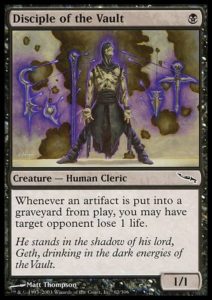I haven’t played much Standard in a while. The last tournament I played was a PPTQ swan song for [casthaven]Elspeth, Sun’s Champion[/casthaven]. I helped my friend Lee test for Pro Tour Battle for Zendikar, though, so I’m not totally useless at the format. In that testing I messed around with Aristocrats-style sacrifice decks alongside more straightforward fare like Atarka landfall and Jeskai. My “Fiery Abzan” build wasn’t at all tuned, but it felt decent enough that I figured someone would find a real deck.
Naturally, Christian Calcano’s Dimir Aristocrats deck caught my eye during the Pro Tour coverage. Pascal Maynard built the deck, and it really solves the [casthaven]Nantuko Husk[/casthaven] problem. Husk is the key piece of the deck, the only free and repeatable sacrifice outlet available other than [casthaven]Butcher of the Horde[/casthaven], but if you can’t make it evasive you have to devote more card slots to alternate win conditions. Now that [casthaven]Mogis’s Marauder[/casthaven] is gone, it’s hard to make a giant husk unblockable. [casthaven]Rogue’s Passage[/casthaven] is too slow—you can play one if you want, but you can’t rely on having it when you need it.
[casthaven]Whirler Rogue[/casthaven] is the best “unblockable” effect available, but it demands a lot of blue mana. What other blue cards do you really want to play? [casthaven]Sidisi’s Faithful[/casthaven] caught my eye during testing as a reasonable card for this style of deck, but I never made the connection with [casthaven]Liliana, Heretical Healer[/casthaven]. Turns out those two cards are bonkers together. The combo is strong enough to justify playing a Dimir deck. [casthaven]Whirler Rogue[/casthaven] also gives you something to do if [casthaven]Anafenza, the Foremost[/casthaven] is chilling on board. I watched Calcano beat Anafenza on stream, and I knew the deck was legit.
The deck hasn’t gotten a lot of traction since the Pro Tour, but it is a lot of fun to play and has some subtle strengths. I chose to play the deck at a Standard PPTQ last weekend at local Denver store Game Heroes. I chose the deck for three reasons: it has great mana, it isn’t a big target, and it doesn’t get stuck in a lot of draws. Additionally, the deck presents similar on-board complexity to Modern Affinity, which I play pretty well. Consistent speed is the most important consequence of all these factors. People fear an early death to Atarka red, but Dimir Aristocrats can kill on turn four just as well.
Here’s what I played:
Dimir Aristocrats
| Creatures (31) 4 Sidisi’s Faithful 3 Bloodsoaked Champion 4 Sultai Emissary 4 Zulaport Cutthroat 4 Hangarback Walker 4 Nantuko Husk 4 Liliana, Heretical Healer 4 Whirler Rogue Spells (6) 4 Murderous Cut 2 Ultimate Price | Lands (23) 4 Polluted Delta 4 Bloodstained Mire 2 Flooded Strand 1 Foundry of the Consuls 3 Sunken Hollow 7 Swamp 2 Island Sideboard (15) 3 Duress 2 Despise 2 Negate 1 Treasure Cruise 1 Vampiric Rites 3 Drana, Liberator of Malakir 1 Minister of Pain 2 Ruinous Path |
I made three changes from the Maynard and Calcano main deck. Out go one [casthaven]Bloodsoaked Champion[/casthaven], [casthaven]Vampiric Rites[/casthaven], and one [casthaven]Swamp[/casthaven]. In their stead, two [casthaven]Ultimate Price[/casthaven] and one [casthaven]Island[/casthaven]. I know the local metagame favors playing [casthaven]Atarka’s Command[/casthaven], so I wanted more cheap removal to survive. Blocking is this deck’s path to victory in the matchup, and the more instant speed removal you have, the better blocking becomes. [casthaven]Ultimate Price[/casthaven] also can deal with [casthaven]Jace, Vryn’s Prodigy[/casthaven], [casthaven]Tasigur, the Golden Fang[/casthaven], [casthaven]Warden of the First Tree[/casthaven], and man other annoying creatures. I swapped a swamp for an island to make sure I always had enough blue mana.
For the sideboard, I took a different approach from the Pro Tour deck. I did not think many people would play control strategies, but decks with [casthaven]Languish[/casthaven] and [casthaven]Ugin, the Spirit Dragon[/casthaven] can totally trump the deck. Therefore, I filled my sideboard with as many answers for control that also do work in other matchups. [casthaven]Duress[/casthaven] is the easiest, as it is great against control, Atarka decks, [casthaven]Retreat to Emeria[/casthaven], and Jeskai variants. I chose [casthaven]Negate[/casthaven] over [casthaven]Disdainful Stroke[/casthaven] or [casthaven]Dispel[/casthaven] because I felt it hit the most cards that I cared about. [casthaven]Ruinous Path[/casthaven] helps kill [casthaven]Anafenza, the Foremost[/casthaven] in addition to being sweet in long control matchups. [casthaven]Despise[/casthaven] seemed decent as another answer to Anafenza and all sorts of creatures and planeswalkers. [casthaven]Treasure Cruise[/casthaven] and [casthaven]Vampiric Rites[/casthaven] are pure control cards.
I had four slots remaining. [casthaven]Minister of Pain[/casthaven] provides some nice value against small tokens and can even give -2/-2 in combination with Liliana. Finally, I added three [casthaven]Drana, Liberator of Malakir[/casthaven] as a way to apply more pressure against decks that have a hard time killing her (like Atarka Red) and an alternate victory condition if Anafenza shuts down death triggers.
My first round started poorly, as I faced Abzan with a turn three Anafenza and no answer. I was able to take both sideboarded games, however, thanks to removal and plenty of synergy to overwhelm the deck. [casthaven]Ruinous Path[/casthaven] was especially good in game two when my opponent told me after the match that he had [casthaven]Dispel[/casthaven] in hand to protect Anafenza. Round two I beat Naya Dragons. The matchup felt good and she drew poorly, so it was over quickly. Just like that, I was 2-0.
Round three I faced Atarka landfall. I flooded game one and lost, then survived in game two until I could combo out a victory with my opponent at eightteen life. Bringing back a [casthaven]Hangarback Walker[/casthaven] with Liliana for the final [casthaven]Zulaport Cutthroat[/casthaven] trigger sealed it. Game three proceeded like game two, but became an attrition match that I punted away. With my opponent at five, I attacked with my only creatures, [casthaven]Nantuko Husk[/casthaven] and [casthaven]Liliana, Heretical Healer[/casthaven], to take him to one. I should have then sacrificed the husk to flip Liliana, make a zombie, and minus two to bring back [casthaven]Zulaport Cutthroat[/casthaven]. But instead I passed the turn and got comboed out to lose the match. I saw the line but hesitated, probably because I hadn’t practiced enough with the deck.
At 2-1, I needed to keep winning to make top eight. Fortunately I next faced [casthaven]Retreat to Emeria[/casthaven], which I beat easily against minimal disruption. Round five I beat Abzan again. In one key play, I attacked [casthaven]Sultai Emissary[/casthaven] into [casthaven]Shambling Vent[/casthaven] on turn four. My opponent blocked and the emissary was the fourth card in my graveyard that turned on [casthaven]Murderous Cut[/casthaven] with my one open black mana to kill the land.
Now 4-1, I was able to draw round six against another Abzan deck. Success! The top eight was stacked with local talent, headlined by Brandon Nelson piloting the deck I feared the most, Esper control. You can read about Brandon’s deck in Patrick Chapin’s article this week, assuming you have Star City premium. But first, I faced Atarka red.
Game one I fetched an island turn one for [casthaven]Sidisi’s Faithful[/casthaven], which blocked five times before dying to [casthaven]Wild Slash[/casthaven] in combat. A [casthaven]Sultai Emissary[/casthaven] also died that turn, and it manifested a second [casthaven]Sidisi’s Faithful[/casthaven] to crush my opponent’s soul. In game two I had two [casthaven]Drana, Liberator of Malakir[/casthaven] to my opponent’s one [casthaven]Fiery Impulse[/casthaven]. She closed the game quickly as he flooded out.
In the semifinals I met Brandon Nelson. We get paired frequently, and for the second time this year he dispatched me in the top four of a Standard PPTQ and then went on to win the tournament. Game one went well for me, as his turn one [casthaven]Duress[/casthaven] missed and I had three [casthaven]Sidisi’s Faithful[/casthaven] to repeatedly bounce [casthaven]Tasigur, the Golden Fang[/casthaven] and beat down for victory. Games two and three, however, he had the timely [casthaven]Languish[/casthaven] to take control. Both times he lost six life to [casthaven]Zulaport Cutthroat[/casthaven], but I never drew enough gas to finish him off. In game two I had [casthaven]Treasure Cruise[/casthaven], but it drew three lands. In game three, I top decked [casthaven]Ruinous Path[/casthaven] on seven mana to kill Gideon and potentially stabilize, but he had [casthaven]Secure the Wastes[/casthaven] for lethal. My sideboard cards did good work, but it was not enough.
In the end I finished third, good for $100 in store credit that I turned into my fourth copy of [casthaven]Jace, Vryn’s Prodigy[/casthaven] and some other Standard staples to round out my collection. I wish I won, but all in all it was a good result that I can build on as I try to improve my Standard game.
I don’t think I would recommend this deck for Grand Prix Indianapolis this weekend, where I expect Dark Jeskai and Esper Control to dominate the top tables. Esper is very tough, while Jeskai is more winable as you punish their greedy manabase, but you want to play every deck except for those. The four color [casthaven]Rally the Ancestors[/casthaven] deck probably fits the metagame better at this point, but if people are trying to cast [casthaven]Explosive Vegetation[/casthaven] into giant threats, Dimir Aristocrats might be a good choice to kill them before they can interact. Turn four kills are a thing, after all.
Carrie O’Hara is Editor-in-Chief of Hipsters of the Coast.



